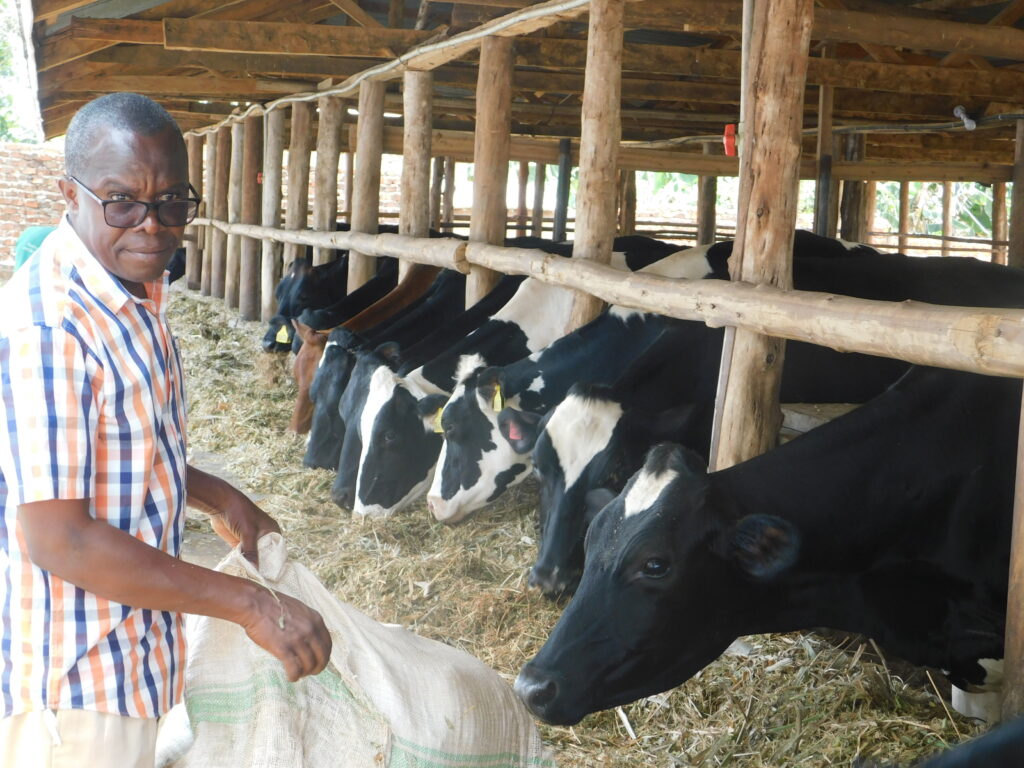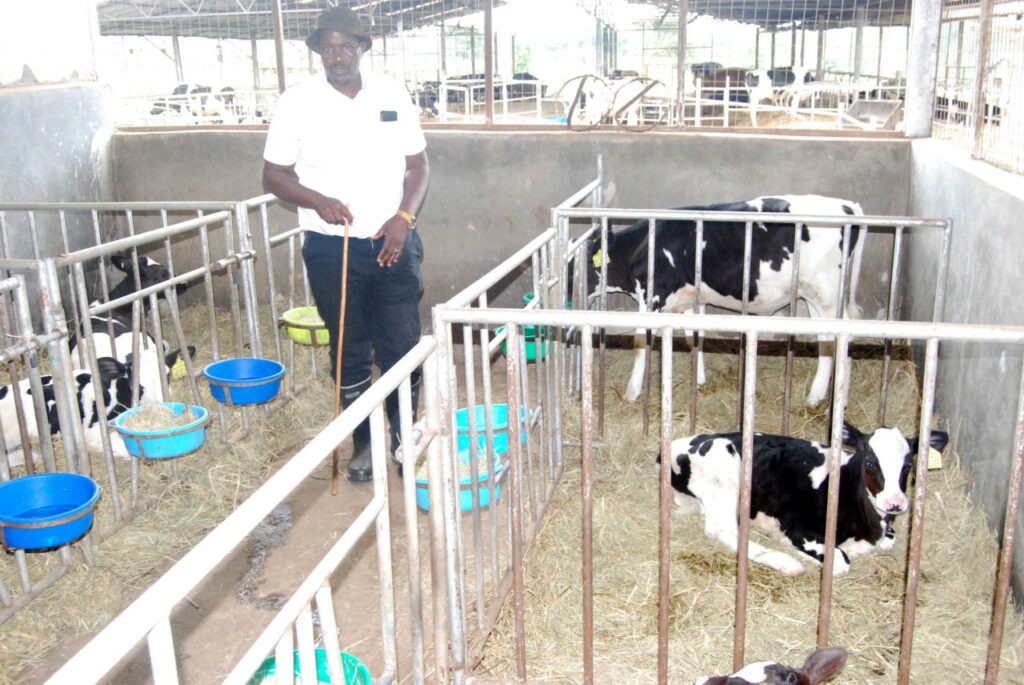By Joshua Kato
If milk could walk, then it would do so with a bounce and swag. If it would sing, then it would be a beautiful melody. The milk sector has every reason to be happy. Just a few years ago, all powder milk that was sold in supermarkets was imported from Kenya and beyond.
Today, the shelves are dominated with locally processed powder milk. A few years ago, it was difficult to find quality locally processed yoghurt, but today, there are over 20 companies making it. This is the same with cheese, ghee and drinking milk. During the State of the nation address on June 8th, President Yoweri Museveni announced that milk production has risen to 5.5bn litres per year, up from 3.2b litres in 2020 or 2.8b litres in 2017. This means that at least 15 million litres are produced per day, the highest ever in Uganda’s history. And as the dairy sector grows, so are opportunities that have risen through the value chain.
According to Dairy Development Authority (DDA), the regulatory body of the sector, the central and southwest contribute 50% of the total national production. The other milk regions particularly eastern and northern experience a deficit of marketable milk almost throughout the year. These are referred to as milk-deficit areas, while south-western and central regions continue to experience a surplus of marketable milk particularly in the wet season.
According to Henry Lugolobi, owner of Sight Farm, Namulonge, Wakiso district and a member of Dairy Farmers Network (DAFAN) which mainly includes mid-level zero grazing farmers, Wakiso and Mpigi districts are also quickly catching up as a big producer of milk among urban areas. According to the Wakiso District Production office, there are over 400 dairy farmers in Wakiso district.

Evolution of the dairy sector
Ofall sectors that have enjoyed tremendous growth since independence is the dairy sector. Around 1963, according to the Uganda Status Report, there were around 5,000 hybrid milk cows in the central region and another 1,000 in other parts of the country. At the time, each mature milking cow cost sh1,000, of course, big money at the time, compared to averagely sh4million today. In 1978, at least 3,000 more hybrid milking cows were brought in to improve the local dairy herd. These were scattered around the government ranches including Entebbe, Nshaara, Ruhengeri etc. since then, numbers have continued growing. As of 2022, there were around 2.7 million hybrid milking cattle in the country.
While the sector showed tremendous growth in the 70s, the war in Luwero and around the cattle corridor in the 80s affected the sector. After 1986, a reorganisation of the ranches in the cattle corridor was carried out. More large investors in the sector took up ranches and started investing in high milk producing cattle, as opposed to indigenous breeds that they traditionally kept. Ever since the launch of the first modern milk processing plant in 1960s, Uganda’s annual milk production has grown from around 100 million litres in the 60s to 368million in 1991 to 1.24bn litres in 2010 to around 2.8bn litres in 2019-according to records from the Dairy Development Authority (DDA) and Ministry Agriculture Animal Industry and Fisheries (MAAIF). DDA was established in 1998 purposely to regulate and improve the dairy sector
Milk consumption can improve
According to a Dairy Development Authority (DDA) report carried out by Richard Ariong and Kenneth Otikal, in February 2022, local home-based milk consumption remains low in Uganda. Milk consumption at levels recommended by World Health Organisation (WHO) and Food for Agriculture Organisation (FAO), of at least 200-250 litres per person per year, would translate to a daily milk intake of about 550m litres per day for the entire Ugandan population.
“Individual annual consumption per year was about 63 litres of milk. Based on these estimates, the findings reveal that individual milk consumption in Uganda is 68% less of the required WHO dietary intake,” the report says. The results further indicate that one person in Uganda consumes the recommend quantity of milk for about only two days in a week which explains low domestic milk consumption in terms of annual per capita or daily requirement. After adjusting the sample to only the population that reported consumption of milk, the results showed that the actual milk consuming population takes milk (77 litres per capita) which is about 22% higher than the estimated national average of 63litres. Comparatively, according to FAO, the average consumption in Europe is 240 litres, while it stands at 170 litres in the US. Kenya has an average of around 90litres.
According to the report, regional and Rural-Urban comparison reveals that the highest per capita consumption is by the population in western region (77 litres per capita) followed by central region (71 litres per capita) while eastern region had the lowest consumption (48 litres per capita) which is generally expected because western and central regions are also the leading producers of milk in Uganda while eastern and northern are the lowest producers of milk.
There are opportunities in both low level and mid -scale value addition on milk. Betty Mbaziira Kasabiti, a dairy farmer in Isingiro district explains that there are several ways of improving milk production along the value chain. “There are people who do not consume milk directly, but can do so when they consume foods like yoghurt or ghee or even cheese,” she says. Mbaziira, who also processes yoghurt and ghee wonders why the country still imports cheese, yoghurt etc and yet local milk production has increased. “Let us invest in adding value to milk. Let us produce more quality yoghurt, let us produce more quality cheese,” she says.

Improved genetics, better breeding
“There are more farmers keeping improved milk cattle across the country than it was 10 years ago,” says Dr Jolly Kabirizi, a Livestock Nutrition expert and a zero grazer with about seven milk cows in Seguku. According to MAAIF statistics, there is an estimated 15.5 million cattle in the country, of which 2.7 million are improved milk cows. Just a few years ago, in 2008, the number of pure milk cows stood at less than one million. Through various technologies, it is now common for dairy cows to produce at least 18litres of milk per day, up from 10litres a few years ago.
“More farmers are adopting the use of artificial insemination (AI) and embryo transfer for dairy cattle and more farmers are going for the improved breeds that produce more milk,” says Dr Patrick Ssekimpi owner of Gaza Dairy Farm in Busiika, Luwero district. The farm has around 80 zero grazing cows, with a target to have 200 high quality cows in the next two years. There are many farmers like him.
Across South-West and Central region areas of the cattle corridor, most of the ranches that were once roamed with indigenous breeds are now covered by dairy cattle. “This trend has increased in the last 10 years and it is set to continue,” says Colonel Dick Bugingo, a dairy farmer in Kiruhura. He pointed out that farmers finally saw the value in milk cows, compared to the ‘pride’ that came with keeping the indigenous Ankole cattle. Bugingo`s prediction is that in the next 20 years, as land further dwindles, semi-zero grazing even within the now expansive cattle corridor will be the main option.
“We have small dairy units, but with intensified feeding methods in order to maximize production,” says Nicholas Matsiko from Kashaka, Mbarara, who is already practicing semi-zero grazing on his farm.
But with increased stocking of better breeds, so is the need for breeders of quality dairy cows. “A good dairy cow that can give at least 25litres a day goes for between sh8-12m at the moment,” says Dr Willim Kabanda, a Veterinary officer, working with URUS. He explains that farmers who are investing in breeding and are doing it right are making money.
Engage in pasture production for cash
In addition to keeping improved breeds, the National Agricultural Research Organisation (NARO) through its livestock arm, the National Livestock Resources Research Institute (NaLIRRI) has in the last 10 years increased multiplication of grasses that improve milk production.
“When you move around the major cattle keeping areas, you see a lot of people planting better pastures,” Dr Jolly Kabirizi, who joined the livestock sector as a nutrition expert in 1972. Kabirizi retired from NaLIRRI in 2017, after 44 years of service and has witnessed the growth of the dairy sector. This grass is improving milk production among dairy cattle. Kabirizi says that there is now an increase in demand for quality feeds, especially pastures and nutrient blocks. “You can earn from the sector by just growing pastures, even if you don’t have cattle,” Kabirizi says. All you need is land.
Allan Iga is one of the farmers who picked the grass growing line in the value chain. “I grow pastures on over 10acres, but I also help farmers process their own pastures into hay or silage,” he says. In addition to growing pastures, Iga also acquired equipment that is used to process the grasses. These include silage choppers and hay balers for example. A kilogram of processed silage costs as much as sh400, the same as a kilogram of hay. A dairy cow in Uganda, feeding at optimum needs about 40kgs of feeds per day.
How to invest in capital for dairy cattle –tips by DDA
A farm requires a large one-time expenditure to get started. Whether you plan to buy or start it all yourself, make sure you’ll have the following basic facilities:
- cow shed protected from weather and temperature changes,
- feed storage area,
- store for farm equipment and drugs,
- separate cubicles for calves,
- equipment (forage chopper),
- fodder chopping area,
- water source,
- resting area,
- feed and water troughs,
- milking place,
- calf housing,
- manure pit and,
- a holding crush
You must have a breeding plan for dairy cattle
-A good dairy cow costs between sh8-sh10m. You are advised to use Artificial Insermination (AI) for fertilization. Artificial insemination has equal or higher success rates when performed correctly (by trained AI technician).
-You will need to breed your cows and heifers regularly to keep them lactating as often as possible. The cycle of breeding, calving, and weaning calves has implications for the animal’s nutrition needs, health, and of course milk production.
-Unlike farms that raise livestock for meat, you will be calving all year round to keep milk production steady.
-Keeping track of where each animal is in the cycle is vital so you can stick to a plan that keeps your income as regular as possible. Please note that for a successful dairy enterprise a farmer must ensure “One cow, one calf, one year (a calf per year)”.





